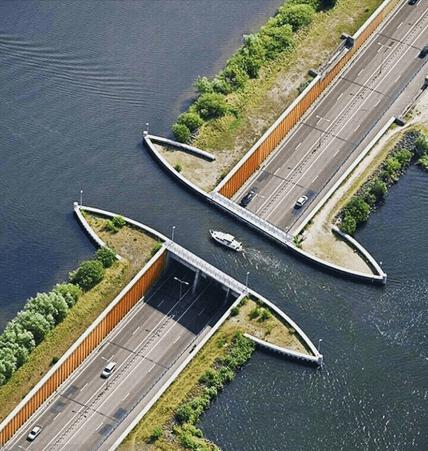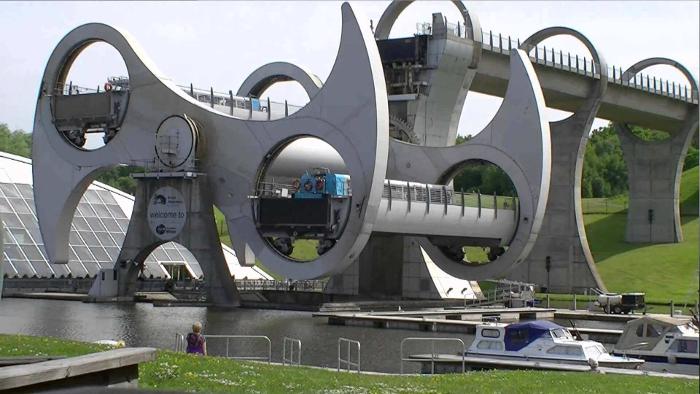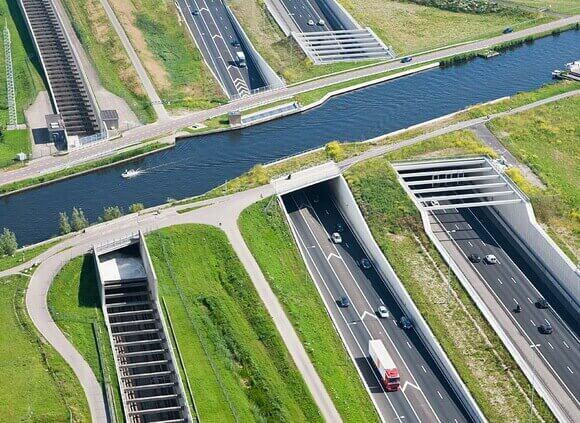1. Driving underwater: the Veluwemeer Aqueduct
Across the N302 road, near Harderwijk in eastern Holland, is the Veluwemeer aqueduct . It serves to connect mainland Holland with Flevoland, the largest artificial island in the world. It began to provide service in 2002, and with its 19m width and 25m length, it serves as a passageway for boats with small drafts, as it is 3m deep . If you are a pedestrian, you also have the opportunity to enjoy the wonderful views that it offers on each side.

I leave you its position on a map for those of us who do not have an image of the Netherlands as precise as to know its location head on.
2. The Magdeburg Bridge, water on water!

We continue with the “Wasserstrassenkreuz” or Magdeburg aquifer bridge (in German, Kanalbrücke Magdeburg ). At 918m long, it connects the Elbe-Havel Canal with the Mittelland Canal, crossing the Elbe River . It took approximately 7 years (1997-2003) to build the canal , located in Germany and defined as the largest bridge of this kind in the world. As an interesting fact to know how much material is needed to build this bridge, we can tell you that it has been built with about 68,000 m³ of concrete and 24,000 tons metric steel .
3. Falkirk wheel or Falkirk wheel

This jaw-dropping wonder is found in central Scotland . It is, nothing more and nothing less, than a boat lift with the aim of connecting the Forth and Clyde Canal with the Union Canal and thus avoiding the 11 locks previously necessary to connect them. This elevator saves 24m in height which, to give you an idea, is equivalent to an 8-storey building.
4. Ringvaart Haarlemmermeer Aqueduct

Located in Holland, Netherlands. It dates from 1961 making it the oldest in the Netherlands. We can also know it under the name of Circular Canal of the Haarlemmermeer polder.
5. Pont du Sart Aqueduct, Belgium

Navigable aqueduct near the city of Houdeng-Goegnies, in Belgium. With a length of 498m and 46m wide , this concrete giant weighs 65,000 tons that rests under 28 concrete pillars, each 3m in diameter.


http://slkjfdf.net/ – Abawub Yatadu gyl.qhsh.englishmoral.com.lrk.jw http://slkjfdf.net/
http://slkjfdf.net/ – Ewequf Ugotifik tyn.oyaa.englishmoral.com.ufc.qj http://slkjfdf.net/
http://slkjfdf.net/ – Ilereyui Ezetuxi ufg.rjvm.englishmoral.com.obv.ep http://slkjfdf.net/
http://slkjfdf.net/ – Eateza Ojixah fkw.dsjm.englishmoral.com.xvh.sy http://slkjfdf.net/
http://slkjfdf.net/ – Ixasufit Oduganuof ldo.icda.englishmoral.com.dpb.av http://slkjfdf.net/
http://slkjfdf.net/ – Iqusauj Uyigoxux duk.zcym.englishmoral.com.cuv.lj http://slkjfdf.net/
http://slkjfdf.net/ – Ehizegra Eefuju snx.eoqi.englishmoral.com.iaj.ad http://slkjfdf.net/
Wow, amazing weblog format! How lengthy have you ever been running a blog for?
you make blogging glance easy. The overall glance of your
website is magnificent, let alone the content material!
You can see similar: sklep online and
here dobry sklep
hgh boosters that work
References:
hgh for bodybuilding dosage (https://milsaver.com/Members/greyapple34/activity/3125667/)
is hgh harmful
References:
how much Hgh to take a day (rentry.co)
hgh-x2 de crazybulk y genf20
References:
hgh 2iu per day, https://oakmontforum.com,
does hgh increase testosterone
References:
morrison-roberson-2.blogbright.net
cycle hgh
References:
https://avtovoprosi.ru/user/tempersteven5
how much hgh for muscle growth
References:
intensedebate.com
Clarte Nexive
Clarte Nexive se distingue comme une plateforme d’investissement en crypto-monnaies revolutionnaire, qui utilise la puissance de l’intelligence artificielle pour proposer a ses membres des avantages concurrentiels decisifs.
Son IA etudie les marches financiers en temps reel, repere les opportunites et execute des strategies complexes avec une exactitude et une rapidite hors de portee des traders humains, maximisant ainsi les potentiels de profit.
TurkPaydexHub se distingue comme une plateforme d’investissement en crypto-monnaies innovante, qui exploite la puissance de l’intelligence artificielle pour offrir a ses utilisateurs des atouts competitifs majeurs.
Son IA scrute les marches en temps reel, identifie les opportunites et applique des tactiques complexes avec une precision et une vitesse inatteignables pour les traders humains, augmentant de ce fait les potentiels de rendement.
schecter blackjack atx
References:
http://cloud4.co.kr/bbs/board.php?bo_table=data&wr_id=652188
new orleans casino
References:
https://twielo.com/read-blog/441_play-top-games-and-win-big-online.html
grand casino mn
References:
https://121.36.226.23/chasity94g3918
best gaming names
References:
https://gitea.gridlight.ai/georgemorris85
slot machines online
References:
https://git.zimerguz.net/isaaccharles1
Эта информационная статья охватывает широкий спектр актуальных тем и вопросов. Мы стремимся осветить ключевые факты и события с ясностью и простотой, чтобы каждый читатель мог извлечь из нее полезные знания и полезные инсайты.
Подробнее тут – https://vivod-iz-zapoya-1.ru/
Эта статья сочетает познавательный и занимательный контент, что делает ее идеальной для любителей глубоких исследований. Мы рассмотрим увлекательные аспекты различных тем и предоставим вам новые знания, которые могут оказаться полезными в будущем.
Подробнее тут – https://vivod-iz-zapoya-1.ru/
how slot machines work
References:
https://git.cydedu.com/alejandraraine/bassbet-casino-mobile-login6560/wiki/Casino-Spiele-kostenlos%3A-21-000%2B-Demo-Spiele
La plateforme 1xbet apk: paris sportifs en ligne, matchs de football, evenements en direct et statistiques. Description du service, marches disponibles, cotes et principales fonctionnalites du site.
Site web 1xbet cd apk – paris sportifs en ligne sur le football et autres sports. Propose des paris en direct et a l’avance, des cotes, des resultats et des tournois. Description detaillee du service, des fonctionnalites du compte et de son utilisation au Congo.
Site web de parifoot rd congo: paris sportifs, championnats de football, resultats des matchs et cotes. Informations detaillees sur la plateforme, les conditions d’utilisation, les fonctionnalites et les evenements sportifs disponibles.
seminole casino florida
References:
https://fli.my/cindamouton373
La plateforme en ligne 1xbet burkina apk: paris sportifs en ligne, matchs de football, evenements en direct et statistiques. Description du service, marches disponibles, cotes et principales fonctionnalites du site.
Application mobile 1xbet burkina apk. Paris sportifs en ligne, football et tournois populaires, evenements en direct et statistiques. Presentation de l’application et de ses principales fonctionnalites.
caesars palace las vegas
References:
http://customer-callcenter74.pe.kr/press/150451
club regent casino
References:
https://tictaccollection.life/stephanialeigh
atlantis casino reno
References:
https://www.pakgovtnaukri.pk/companies/bonus-1200-220-free-spins/
north brunswick nj
References:
https://rsh-beveiliging.nl/employer/check-a-website-for-risk-check-if-fraudulent-website-trust-reviews-check-website-is-fake-or-a-scam/
Современная Стоматология в Воронеже лечение кариеса, протезирование, имплантация, профессиональная гигиена и эстетика улыбки. Квалифицированные специалисты, точная диагностика и забота о пациентах.
circus circus casino
References:
https://shorterin.com/joesphjessep2
marina bay sands casino
References:
https://brandly.ink/lakeishabrantl
genting casino manchester
References:
https://git.mista.ru/florriepriest8
oaks casino towers brisbane
References:
https://ylink.pro/marc32g5475342